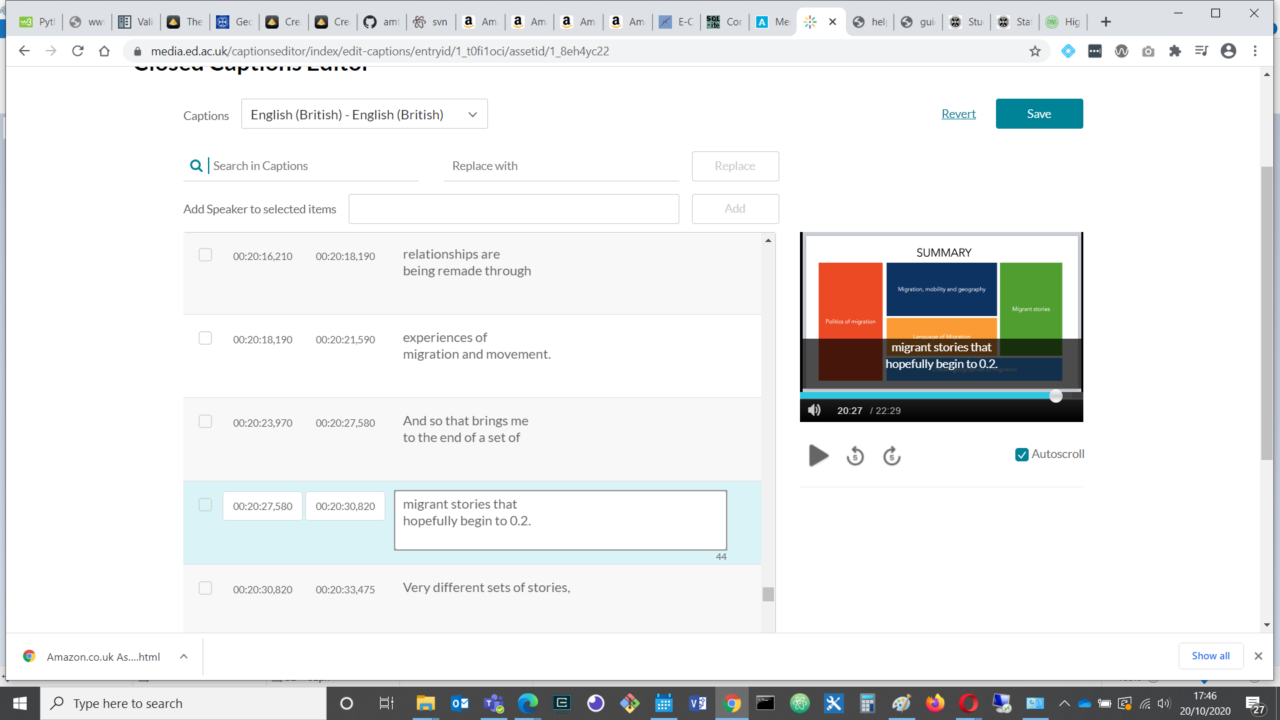One of the unexpected but nice parts of my job lately has been editing the automated subtitles on some of our teaching videos.
This is a requirement for our course materials, to ensure our videos are more accessible for, for example:
- Deaf students
- Students with other hearing difficulties, for whom subtitles can help with comprehension of fast spoken or unclear dialogue, perhaps spoken with unfamiliar accents, mumbling, or with background noise
- Foreign language speakers, for whom the subtitles might help with translation and following along with the spoken text
- Students with learning disabilities, attention deficits, or autism, who may find subtitles help them to maintain their concentration on the videos
- Students who need to study in a place where they can’t play sound
- Students who need to see the spelling of proper nouns, such as full names, brand names, or technical terms
- Students who just prefer to watch videos with subtitles as a habit
According to research by Ofcom in 2006, 7.5 million people in the UK (18% of the population) used closed captions, and of these, only 1.5 million were deaf or hard of hearing. 80% of those who preferred to watch with subtitles used them for other reasons.
Since we moved to hybrid learning, we have more and more teaching videos to work on, so that is an occasional silver lining to social distancing for me, as subtitling is a nice, quiet and absorbing task, and our videos are often very interesting 🙂
At the moment, this is still more of a multi-step process than we would like. The videos get uploaded to our Media Hopper service, which is like a University gated equivalent of YouTube. We can request automated captioning for each video. Once the captions have been added, we go back to the video and edit them using the subtitle editing interface (see below).
The screenshot below shows the interface we use, as well as a good example of why correcting the subtitles is often necessary:
Today’s work has also been a nice change in a different way. Most of the courses I have been involved in so far have been on the physical sciences side of GeoSciences, but today I got to edit (and therefore watch, a lot!) some interesting Geography videos about refugees and migration.
I’ve been an immigrant myself, but never a refugee, so it was very interesting to me to hear more about their stories. I remember it being hard enough when you do get to plan, bring your stuff with you, and work with the best chances you can, so I found some of this quite moving.
Here is one of the videos whose subtitles I edited today:
Migrant Stories
Links (but wait… there’s more…)
Here are some links about subtitling, and about some of the issues and artistic works discussed in the video:
- How Many People Use Subtitles? Not Just the Deaf or Hard of Hearing – 3PlayMedia
- Lights, camera, caption! Why subtitles are no longer just for the hard of hearing
- Laundromat: ai weiwei fills NY gallery with thousands of garments gathered from refugee camps
- The Journey: Syrian refugee Hashem Alsouki risks his life crossing the Mediterranean, his sights set on Sweden – and freedom for his family
- Nanay (Mother): a testimonial play, by Caleb Johnston and Geraldine Pratt
- Migration and New Media: Transnational Families and Polymedia
Oh no
In the Amazon summary for the last book mentioned, I read this:
How do parents and children care for each other when they are separated because of migration? The way in which transnational families maintain long-distance relationships has been revolutionised by the emergence of new media such as email, instant messaging, social networking sites, webcam and texting. A migrant mother can now call and text her left-behind children several times a day, peruse social networking sites and leave the webcam for 12 hours achieving a sense of co-presence…
New media, understood as an emerging environment of polymedia, have become integral to the way family relationships are enacted and experienced. The theory of polymedia extends beyond the poignant case study and is developed as a major contribution for understanding the interconnections between digital media and interpersonal relationships.
Should this really be ok though: mothers from poorer countries caring for wealthier countries’ children, while being only distantly connected to their own children through webcams and Facebook?
I don’t know: this ended a lot less happy and optimistic than it started. Technology is such a doubled edged sword. I know from my own experiences of having family at a distance that connecting through social media is an illusion that doesn’t really substitute for genuine closeness. But, putting the current pandemic situation aside, how and where can we draw the line between making ways to connect at a distance possible and making them feel compulsory?
All I can answer is that for myself I am very lucky to be living with my own children, working and raising them myself with the help of good schools and great non-exploitative-seeming after school childcare and clubs, and always watching videos with subtitles by choice (and I admit, they do help me concentrate 😀 ). What else can I say? Not everyone is so lucky.
Finally, it strikes me that I have been using technology to make it more accessible for our students to learn, online due to social distancing, about the distances that occur when people migrate, and how technology can sometimes be used to some extent to bridge the gaps between them.
Time for me to end this technological soul searching, though I do hope and assume that someone is researching this. Instead let’s get the kettle on and laugh at one last error from this comedy of subtitles:
The End.





Leave a Reply